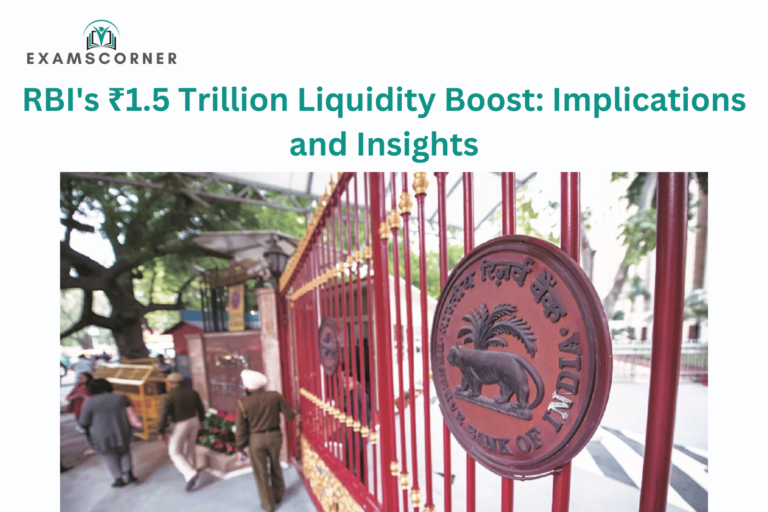Introduction
The Reserve Bank of India (RBI) recently announced a series of measures aimed at injecting liquidity into the banking system, collectively amounting to ₹1.5 trillion. This decision comes against the backdrop of persistent liquidity deficits in the banking sector, mounting pressure on the rupee, and economic challenges requiring immediate attention. Let’s break down the key aspects of these measures, their implications, and the broader context. In this article we were see about RBI’s ₹1.5 Trillion Liquidity Boost their Implications and Insights.
Why Did the RBI Step In?
Since mid-December 2024, the banking system has experienced a liquidity deficit exceeding ₹1 trillion. This contrasts sharply with the surplus observed between July and November 2024. The average deficit recently soared to ₹3.3 trillion, driven primarily by substantial Goods and Services Tax (GST) outflows and subdued government spending.
Moreover, the RBI’s interventions in the forex market to stabilize the rupee over the past two years have contributed to this deficit. The rupee has faced downward pressure, particularly since September 2024, due to aggressive selling of Indian equities by foreign portfolio investors. With a depreciating rupee and slow fiscal spending, the liquidity crunch has become a pressing concern for the financial system.
Key Measures Announced by the RBI
To address the liquidity shortfall, the RBI has rolled out the following measures:
- Open Market Operations (OMO):
- The RBI will purchase government securities (G-Secs) worth ₹60,000 crore in three tranches of ₹20,000 crore each. OMOs are tools used by central banks to regulate liquidity in the banking system by buying or selling government bonds. By purchasing G-Secs, the RBI injects liquidity into the system, ensuring banks have more funds to lend.
- Variable Rate Repo (VRR) Auction:
- A 56-day VRR (Variable Rate Repo) auction of ₹50,000 crore is scheduled for February 7. Repos are short-term loans where banks borrow funds from the RBI by pledging securities. The “variable rate” mechanism allows banks to bid for funds at competitive interest rates, ensuring efficient allocation of liquidity.
- Dollar-Rupee Sell Swap Auction:
- On January 31, the RBI will conduct a $5 billion dollar-rupee sell swap auction for a six-month tenor. In this arrangement, the RBI buys dollars from banks in exchange for rupees, releasing ₹43,000 crore into the system. After six months, the transaction is reversed, with the RBI selling the dollars back to the banks.
Additional Liquidity Measures
In addition to the above, the RBI has:
- Reduced the cash reserve ratio (CRR) by 50 basis points in December 2024.
- Conducted daily VRRs and secondary market OMOs worth ₹10,000 crore earlier this month.
- Gradually shifted its stance on forex management, allowing the rupee to depreciate at a controlled pace to conserve forex reserves and maintain liquidity.
Expected Benefits of the Measures
The cumulative impact of these measures is expected to inject ₹1.5 trillion into the banking system over time. Here’s how this liquidity boost will help:
- Addressing the Liquidity Deficit:
- While the ₹1.5 trillion infusion won’t entirely bridge the ₹3 trillion deficit, it provides much-needed relief to the interbank market. Scheduled OMOs add predictability, reducing market uncertainty.
- Supporting Banks’ Needs:
- The VRR auction ensures banks have sufficient liquidity to meet operational requirements, particularly as the fiscal year-end approaches on March 31.
- Enhancing Policy Transmission:
- Liquidity injections improve the transmission of monetary policy measures, ensuring that rate cuts and other policy actions have the desired effect on lending rates and economic activity.
Is This a Prelude to a Rate Cut?
Market analysts and bankers speculate that the RBI’s liquidity measures signal a potential rate cut. By injecting liquidity, the RBI facilitates smoother policy transmission, which is essential for rate cuts to impact borrowing costs effectively. Additionally, the timing of the 56-day VRR auction, coinciding with the monetary policy announcement, hints at a possible reduction in policy rates.
However, the likelihood of a rate cut is tempered by persistent inflationary pressures—currently hovering around 5%—and the rupee’s depreciation to record lows. These factors may prompt the RBI to adopt a cautious approach in the near term.
Broader Implications
The RBI’s measures reflect a delicate balancing act between addressing immediate liquidity concerns and maintaining macroeconomic stability. They underscore the central bank’s commitment to supporting the financial system while managing inflation and currency volatility.
For businesses and consumers, the liquidity boost could translate into easier access to credit and potentially lower borrowing costs in the medium term. However, sustained economic growth will require complementary fiscal measures, increased government spending, and structural reforms to address underlying economic challenges.
Conclusion
The RBI’s ₹1.5 trillion liquidity boost is a timely intervention aimed at stabilizing the financial system amid growing pressures. While it provides a temporary reprieve, long-term solutions will depend on coordinated efforts between monetary and fiscal policymakers. As India navigates this complex economic landscape, the central bank’s actions will remain pivotal in shaping the nation’s financial resilience and growth trajectory.






